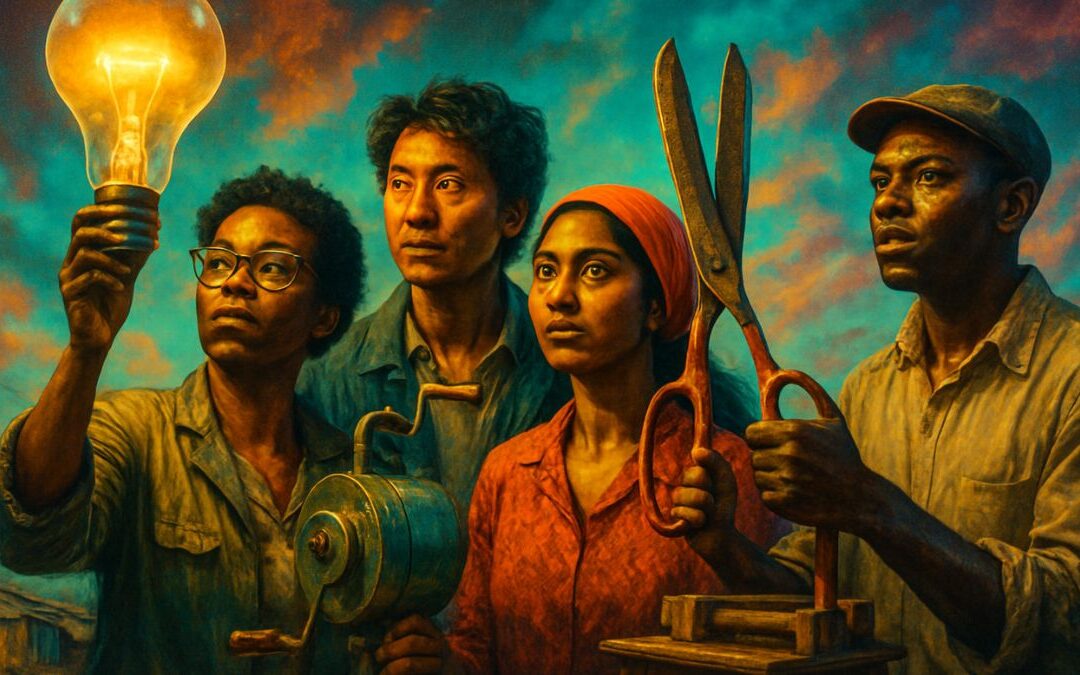- Agriculture Revolution: The Neolithic Shift
- Keywords
- Key Takeaways
- Frequently Asked Questions (FAQs)
- What triggered the shift from nomadic life to settled agriculture?
- How did agriculture lead to specialized roles in society?
- What were the challenges of these new permanent settlements?
- How did trade evolve during the Neolithic period?
- Why were walls and fortifications built?
- How did the concept of leadership emerge during this period?
- What role did art and culture play in these Neolithic communities?
- Did agriculture lead to a healthier diet for early humans?
- What were the main crops grown during the Neolithic period?
- Were there any downsides to the Neolithic Agricultural Revolution?
- Myth Buster
- Myth: The Neolithic period was solely about farming.
- Myth: Early humans immediately excelled at farming.
- Myth: Neolithic humans lived sedentary lives.
- Myth: Agriculture made life easier for early humans.
- Myth: The Neolithic period was a global simultaneous shift.
- Myth: All Neolithic humans were farmers.
- Myth: Walls were built for aesthetic reasons.
- Myth: Neolithic settlements were peaceful utopias.
- Myth: Early agriculture led to immediate population booms.
- Myth: The Neolithic period was short-lived.
Agriculture Revolution: The Neolithic Shift
Imagine this: it’s the Neolithic period, roughly 10,000 years ago. Our scene opens in the vast expanse of the ancient landscape, where a wandering tribe roams. Dave, our trusty protagonist, is having a particularly rough day. His feet hurt, he’s missed the nomadic brunch gathering, and all he’s got in his satchel is a handful of wild seeds and berries. Little did Dave know, those tiny seeds were about to spark one of the most transformative periods in human history.
For eons, humans had been on the move, following the seasonal rhythms, hunting, gathering, and setting up temporary camps. But, the Earth was changing. The last Ice Age had ended, and Mother Nature was flaunting her newly lush and fertile lands. Enterprising individuals like Dave started noticing that those seeds they nonchalantly tossed away sprouted into plants. A lightbulb moment!
Why, Dave pondered, chase after food when you can make the food come to you? And so, Dave tried his hand at early farming. At first, it was all trial and error. Some seeds grew, while others turned into impromptu snacks for local wildlife. But with time, patience, and probably some prehistoric pep talks to the plants, agriculture began to take root.
Dave’s friend, Strategy Sarah, saw the potential. “Look, if we can grow our food consistently, why keep wandering around like lost pigeons? Let’s settle down!” And the idea of permanent settlements was planted.
In these budding communities, not everyone had to farm. Specialist Stan, for instance, was terrible with plants. They wilted at his very approach. But give him some clay, and he’d whip up pottery masterpieces that were both functional and Instagram-worthy (had Instagram existed). With a consistent food supply, people could now diversify their skills. Crafts, trades, and even early forms of administrative roles emerged.
Yet, it wasn’t all smooth tilling. With settlements came the challenge of land ownership and the need to defend resources. Protective Patty, ever the visionary, spearheaded the idea of walls and fortifications. These settlements slowly morphed into the earliest towns.
As these towns flourished, so did trade. Traveling Tom, who missed the good ol’ nomadic days, found his calling as a trader. With his trusty donkey, he’d venture to neighboring settlements, swapping grains for tools, stories for pottery, and gossip for… well, more gossip.
This newfound stability and community spirit led to something unexpected: free time. Creative Cassie, with time on her hands, began dabbling in art, spirituality, and perhaps the Neolithic’s first attempts at interpretive dance.
However, with all these advancements, came new challenges. Managing larger communities meant the rise of hierarchies and leadership roles. Diplomatic Derek had the arduous task of mediating disputes, organizing grain storage, and ensuring everyone put their pottery back in the communal hut.
The Neolithic Agricultural Revolution wasn’t just about farming. It was about innovation, collaboration, resilience, and the occasional hilarious misadventure (like the time Mischievous Mike tried to milk a wild aurochs). It was the bedrock on which empires would be built, cultures would flourish, and histories would intertwine.
As our tale winds down, we return to Dave, now a seasoned farmer, looking over a thriving community with pride. From the seeds of curiosity grew the pillars of civilization, changing the trajectory of human history forever.
From the nomadic tapestry of stars and campfires to the bustling vibrancy of settlements and shared stories, the Neolithic Shift was a transformative era that sowed the seeds for the world as we know it. And to think, it all began with a humble grain and a dream. Hats off to you, Dave, the unexpected hero of the Agriculture Revolution!
Keywords
- Neolithic period: The final stage of cultural evolution or technological development among prehistoric humans, marked by the shift from nomadic hunting and gathering to agriculture and settlement.
- Nomadic brunch: A humorous reference to the mobile and ever-moving nature of early human tribes and their daily routines.
- Agriculture: The practice of cultivating plants and rearing animals for food, raw materials, or other human use.
- Permanent settlements: Fixed communities where people began to live year-round rather than moving around.
- Pottery: Objects (usually vessels) made of clay and hardened by heat.
- Fortifications: Military constructions or buildings designed for defense in warfare.
- Trade: The action of buying and selling goods and services.
- Hierarchies: A system in which members of an organization or society are ranked according to relative status or authority.
- Neolithic Agricultural Revolution: A fundamental change in the way people lived; the shift from hunting and gathering to agriculture led to permanent settlements, the establishment of social classes, and the eventual rise of civilizations.
- Aurochs: A type of large wild cattle that inhabited Europe, Asia, and North Africa; now extinct.
Key Takeaways
- The Neolithic period witnessed a profound shift from nomadic lifestyles to settled agriculture.
- The birth of agriculture was serendipitous and rooted in observation and experimentation.
- Permanent settlements allowed for specialized roles and trades to emerge, fostering innovation.
- The stability of settlements led to increased collaboration and community spirit.
- With the growth of communities came the challenges of resource management and defense.
- Trade became vital, connecting different communities and promoting cultural exchange.
- The Neolithic shift wasn’t just about growing food but also about societal structures and new ways of communal living.
- The period saw the emergence of leadership roles and governance.
- Despite its challenges, the Neolithic Agricultural Revolution laid the foundations for modern civilizations.
- The story underscores the transformative power of a single idea and how it can change the course of history.
Frequently Asked Questions (FAQs)
What triggered the shift from nomadic life to settled agriculture?
The end of the last Ice Age resulted in more fertile lands. As early humans observed that seeds could grow into plants, they began experimenting with farming. Recognizing the advantages of a consistent food source, the idea of settling in one place became more appealing.
How did agriculture lead to specialized roles in society?
With a steady food supply, not everyone had to engage in farming. This allowed individuals to pursue other interests and develop specific skills, from pottery to administration, leading to role specialization.
What were the challenges of these new permanent settlements?
Managing resources, land ownership disputes, and defense against external threats were some of the challenges faced by early settled communities.
How did trade evolve during the Neolithic period?
As settlements grew and people developed specialized crafts and goods, there was a need to exchange these goods with neighboring communities, giving rise to trade networks.
Why were walls and fortifications built?
As communities grew and resources became centralized, there was a need to protect these assets from potential threats, leading to the construction of walls and fortifications.
How did the concept of leadership emerge during this period?
The growth and complexity of settled communities necessitated organization, decision-making, and dispute resolution, leading to the rise of leadership roles.
What role did art and culture play in these Neolithic communities?
With more stability and free time, individuals explored creative outlets, leading to the birth of art, spirituality, and cultural practices, which helped bond communities together.
Did agriculture lead to a healthier diet for early humans?
While agriculture provided a more consistent food supply, early farmers initially had a less diverse diet compared to their hunter-gatherer counterparts. Over time, agricultural practices evolved to encompass a broader range of crops, leading to a more varied diet.
What were the main crops grown during the Neolithic period?
Early Neolithic crops varied by region but commonly included cereals like wheat and barley, as well as legumes and some fruits and vegetables.
Were there any downsides to the Neolithic Agricultural Revolution?
While the Neolithic shift brought many advancements, it also introduced challenges like social hierarchies, land disputes, and potential for conflict over resources.
Myth Buster
Myth: The Neolithic period was solely about farming.
Reality: While agriculture was a significant development, the Neolithic period also saw the rise of settlements, specialized roles, trade, and more complex societal structures.
Myth: Early humans immediately excelled at farming.
Reality: Early agriculture was filled with trial and error. Understanding which crops grew best in which conditions took time and experimentation.
Myth: Neolithic humans lived sedentary lives.
Reality: While there was a shift towards permanent settlements, many individuals still traveled, especially for trade.
Myth: Agriculture made life easier for early humans.
Reality: While it offered stability, agriculture also brought new challenges like resource management, defense, and societal disputes.
Myth: The Neolithic period was a global simultaneous shift.
Reality: The shift to agriculture happened at different times in different parts of the world, influenced by local conditions and cultures.
Myth: All Neolithic humans were farmers.
Reality: The rise of specialized roles meant that not everyone had to farm. Many pursued crafts, trades, or administrative roles.
Myth: Walls were built for aesthetic reasons.
Reality: The primary purpose of walls and fortifications was protection against potential threats.
Myth: Neolithic settlements were peaceful utopias.
Reality: While there was a strong sense of community, these settlements faced challenges, from resource disputes to external threats.
Myth: Early agriculture led to immediate population booms.
Reality: While agriculture eventually supported larger populations, initial adoption did not result in immediate population explosions.
Myth: The Neolithic period was short-lived.
Reality: The Neolithic era spanned thousands of years, with various developments happening at different times across regions.











0 Comments